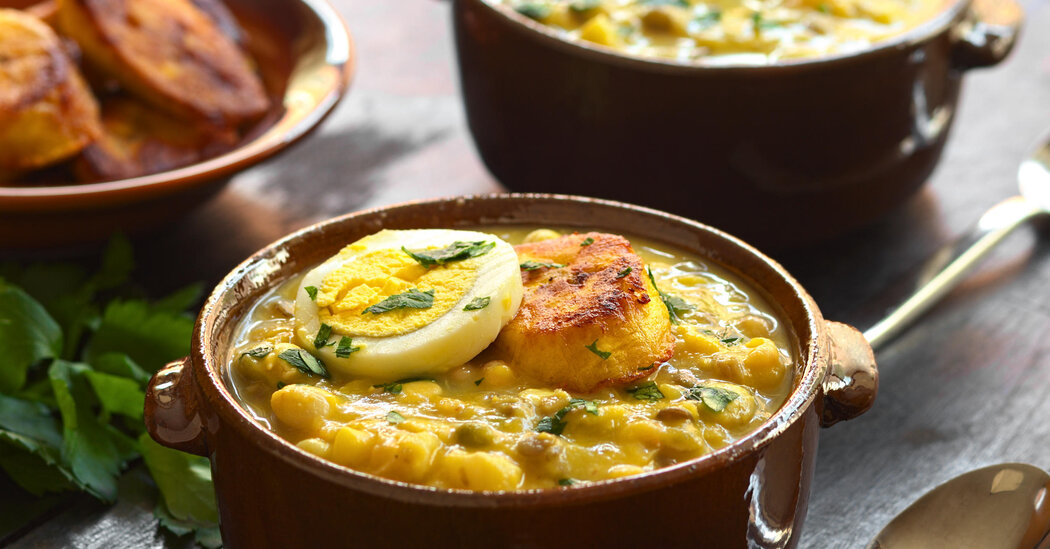More than 40 years ago, a statue of the Virgin of El Quinche was brought to the United States by a family from Ecuador. To celebrate its arrival at the now-shuttered St. Ann’s Church in Lower Manhattan, Rosa Cartagena and a team of women started a new tradition at the church: making and selling fanesca, a soup so labor-intensive that it is served for only a limited time during the Lenten season.
For decades, the group has gathered donations and at least four women will meet each year at Mrs. Cartagena’s home in Hempstead, N.Y., to cook about 100 bowls of the soup they all grew up eating in Ecuador during Holy Week. And as Easter approaches, the soup will be served at churches, restaurants and homes throughout the country that serve Ecuadoreans and other Latin Americans.
Fanesca typically contains at least a dozen ingredients, to represent the Twelve Apostles. There are beans — red, white, lupin, fava and butter — along with chickpeas, lentils, corn and rice. Many Roman Catholics don’t eat meat on certain days during Lent, so some cooks will soak salted cod in milk and use both in the soup. For the base, zapallo — a squash similar to zucchini — is cooked until tender.
Toppings include fried plantains, cheese empanadas, more fresh cheese, hard-boiled eggs, the cod, a piece of spicy red pepper and a sprig of parsley or cilantro.
The day before Palm Sunday, the women come to Mrs. Cartagena’s home to help her peel and cook each ingredient in her mother’s recipe. On Palm Sunday this year, Mrs. Cartagena and her helpers will mix everything together in the kitchen of the Church of Our Lady of Guadalupe at St. Bernard in the West Village. A bowl is $15, slightly more expensive this year because of inflation, but it includes arroz con leche for dessert. The money collected is donated to the church.
“I honor my mother by continuing this tradition in the church and in my home,” Mrs. Cartagena said in Spanish. “The community is our family.”
The fanesca people eat today is a product of Indigenous traditions and ingredients from Ecuador and Spain, said Carolina Pérez, a gastronomy professor at the Universidad de Las Américas, in Quito, Ecuador. Indigenous groups in what is now Ecuador once celebrated and thanked the Pachamama, a goddess people worshiped in the Andes, for a good harvest in the springtime. Mrs. Pérez said they likely made a similar soup using native squash and grains. Milk, cheese, salted cod and eggs were introduced by the Spanish, and the soup became associated with Holy Week after many people were converted to Catholicism.
“It shows the diversity of our culture and traditions,” Mrs. Pérez said in Spanish. “We have a lot of affection for it. It’s a dish that helps us reunite with our families.”
In Ecuador, restaurants try to outdo one another with their fanescas, and that pride can be found in the United States, too. In Tulsa, Okla., at her Ecuadorean restaurant, Que Gusto, Carla Meneses serves the soup just one day a year: March 29. She’ll pull an all-nighter to prepare more than 100 bowls of the soup and its garnishes. The day before she serves it, she’ll knead salted cod from Norway in milk. She already has her lupin beans, known as chochos in Ecuador, peeled and ready.
“It’s a nuisance,” she said in Spanish, laughing. “My employees are already complaining.”
Mrs. Meneses recalled her grandmother’s teaching her and her three sisters how to make the soup in Quito. “That Easter Sunday, it was all the family around with fanesca,” she said. “It had to be something great. The memory has to last until next year.”
Other cooks, like Ana García in Alexandria, Va., want people to buy the soup throughout the year. She makes a vegan version — using plant-based dairy, zucchini and cabbage, along with other traditional ingredients — every day at pop-ups and farmers’ markets through her business, Ana’s Twist. In Quito, where she’s from, she even introduced a sweet version of fanesca at the ice cream shop she owned with her husband.
On Good Friday, people will eat only the soup. “It’s a lot,” she said.
Follow New York Times Cooking on Instagram, Facebook, YouTube, TikTok and Pinterest. Get regular updates from New York Times Cooking, with recipe suggestions, cooking tips and shopping advice.







